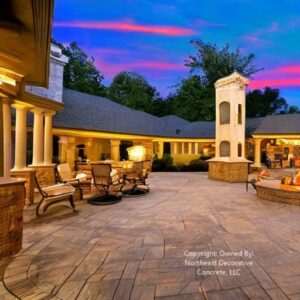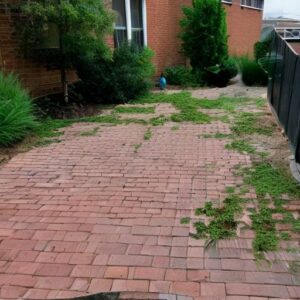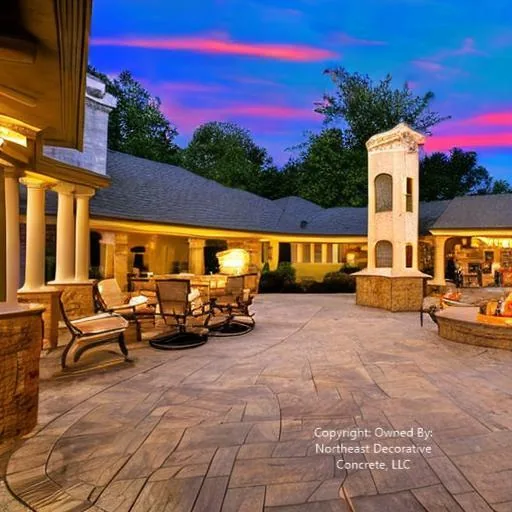
Looking for an affordable option for your outdoor design project? Learn about the costs associated with stamped concrete and pavers and find out which is the cheaper choice for you.
Is it Cheaper to Do Stamped Concrete or Pavers?
Stamped concrete and concrete pavers are both popular materials for patios and pool decks. Stamped concrete is more than 25 percent cheaper than pavers cost and offers a variety of colors and patterns. Both decorative concrete and brick surfaces should be sealed regularly for increased durability. Still, concrete stamping may require more frequent sealant applications. In contrast, concrete pavers offer constant weed picking between the loose bricks and regular bi-yearly polymeric sand to be reapplied between the joints to prevent them from failing.
When deciding between pavers and stamped concrete slabs, and brick surfaces for pool decks or walkways, designers must consider cost, strength, maintenance requirements, lifespan, ease of repair, stain color, and texture options. Decorative concrete is generally cheaper and offers more variety; Ultimately, the decision should be based on the specific needs and preferences of the project.
The Average Price a Square Foot For Brick Pavers Installed (2023)
- The average price in the (USA) is $16 to $25 dollars per square foot.
- Up in New England; you are looking at $25 to $50 per square foot installed.
The Average Per Square Foot For Stamped Concrete Patio Installed (2023)
- The average price in the (USA) is $10 to 20 dollars per square foot.
- Up in New England, you are looking at $16 to $20 per square foot installed.
Concrete Stamping Is Cheaper Than Pavers by 25-Percent!
The average middle price in the USA for stamped patio costs is $15 sq. ft., while brick pavers are $20.50 sq. ft. Stamped concrete is more than 25% cheaper than brick pavers in the USA and is comparable to a high end $50 sq. ft. brick pave.

What are The Pros and Cons of Stamped Concrete Slabs?
Decorative concrete is an excellent choice with many benefits for decorative concrete patios, walkways, and driveways because of its affordability, customizability, and long-lasting durability. It is more cost-effective than natural stone, brick, or pavers and offers nearly endless pattern and color options. With minimal maintenance, stamped concrete can last for decades. It comes in many colors, patterns, and textures and can imitate almost any surface, from marble to stone to weathered lumber.
However, there are some drawbacks to consider when selecting basic stamped concrete. First, it requires resealing every 3 to 5 years for proper maintenance.
Overall, concrete stamping has many benefits, including affordability, customizability, and longevity. But it also has some drawbacks, such as resealing every 3 to 5 years. So when deciding if decorative concrete slabs is suitable for your project, make sure to weigh the pros and cons carefully.
What are The Pros and Cons of Concrete Pavers?
Patios, driveways, and walkways can be made more attractive and durable using brick concrete pavers. Pavers come in various colors, shapes, textures, and materials, allowing limitless design possibilities. They are also relatively small, making it easy to create beautiful patterns. In addition, brick surfaces can be durable, and require low maintenance with regular applications of protective sealants and polymeric sand.
However, there are also some drawbacks to using concrete paver patios. Depending on where you live, you may need to obtain a permit before beginning the installation process. Additionally, weeds may grow between the joints of the bricks if the polymeric sand between them washes away. Finally, installing walkway pavers is more expensive than other options, such as concrete stamping, but the maintenance can add up when you need to reapply the polymeric sand frequently.
Moreover, while paver patios can enhance the aesthetics of your outdoor space, they often require careful planning and preparation to ensure a durable installation. For those looking to rejuvenate an existing surface, laying pavers over cracked concrete can be a viable solution, but proper surface preparation is essential to avoid future complications. Lastly, without regular upkeep, the beauty and functionality of a paver patio may diminish over time, necessitating ongoing attention and investment.
Consider your lifestyle and budget when deciding a better choice between concrete and pavers patio surfaces for your outdoor living space.
Which is More Durable: Stamped Concrete Vs. Pavers Durability?
Pavers are an excellent choice for various outdoor projects due to their strength and resistance to freeze-thaw cycles. With a force of 8,000 PSI or more, they are much stronger than poured concrete, which typically has a potency of 3,000-5,000 PSI. Brick surfaces have been used for centuries to create beautiful outdoor hardscapes and have a proven track record of durability in warmer weather conditions, but not in colder states, such as New Hampshire and Massachusetts. Also, decorative concrete is one solid piece, vs. 6-inch x 6-inch bricks. We have taken out hundreds if not thousands of bricks for removal and they easily come out, vs solid piece of concrete which requires a heavy duty commercial grade jack hammer that requires a lot of hard manual work to get the concrete apart, especially if it has steel rebar inside.
Decorative concrete is a newer option offering many pattern and color options at a reasonable cost. However, stamped concrete may require a sealant to be applied more often for comparable durability, which can affect the color.
Pavers are better for weight-bearing areas such as driveways, as they are less likely to crack or break under the weight of vehicles. Over time in areas with heavy rains or cold winters, where the ground is prone to heaving and expanding, they become loose and separate, and impossible to plow snow with a vehicle without damaging them. But stamped concrete poured correctly will have a 5000psi strength with steel rebar and is one solid piece, where bricks come apart and malfunction due to the ground heaving in cold climates, which results in water getting into the crack of joints and causing separation.

Maintenance Repairs: Pavers and Concrete Stamping
Weeds growing between bricks are an all-too-common problem. Airborne weed seeds can drop onto the brick surface and find their way into crevices, where they can germinate and increase. Not only are these weeds unsightly, but they can also cause structural damage to driveways or walkways. To prevent this, it’s essential to maintain your pavers properly and use stabilizing materials like polymeric sand.
To remove existing weeds, you can pour white vinegar or boiling water over them once a week or every two weeks. Regular sealing will also keep determined weed seeds from taking hold. You can keep your pavers looking fresh and free of weeds with the proper care.
Who wants weekly maintenance of picking weeds? All our new customers contact us for a quote because concrete stamping is more durable, long-lasting, and cost-effective. Customers seeking out quotes for stamped concrete know that brick surfaces are high maintenance and only last for a short period of time in the New England area. Every year, we have to rip out customers 2 to 4 year old freshly installed pavers because they have failed so badly, they needed to be replaced instantly. It is quit clear, that decorative concrete pavers vs. its alternatives is more durable than brick surfaces. While decorative concrete needs to be resealed every 3 to 5 years to maintain.
FAQs:
Q. What is The Advantage of Stamped Concrete?
A. The main advantage of existing concrete driveway stamping is that it is durable, easy to maintain, and cost-effective. It can also be stamped with a variety of patterns and colors.
Q. What are The Benefits of Pavers?
A. The benefits of pavers offer include a unique and customizable look and are easy to repair because they are individual pave pieces.
Q. Is it Cheaper to Do Stamped Concrete or Pavers?
A. The cost of either project will depend on the type of material used, the project’s size, and the design’s complexity. Generally, stamping is the less expensive option by at least 25%, but it also can be more cost-effective in the long run. Paving materials, however, are typically more expensive upfront and may require more frequent repairs down the road.
Q. What Lasts Longer, Stamped Concrete or Pavers?
A. Stamping typically lasts longer than pavers because it is one solid piece of concrete and is not prone to shifting as bricks can. Additionally, it is less likely to develop cracks over time.
Q. What is Better, a Patio Stamped Concrete or Pavers?
A. There is no definitive answer to this question as it depends on several factors, including the available space, the budget, and personal preference. For example, decorative concrete is generally more affordable and easier to install, while interlocking pavers are more aesthetically pleasing and durable and allow for more customization. Ultimately, it comes down to what works best for the individual’s needs.
Q. What is a Cheaper Alternative to Stamped Concrete?
A. Cheaper alternatives to concrete stamping is asphalt. They are much less expensive, and the installation process is much simpler and quicker. Additionally, the asphalt can be replaced without tearing up all the concrete.
Q. Is it Cheaper to Lay Pavers or Concrete?
A. Whether it is cheaper to lay bricks or wet concrete depends on the type of patio pavers and concrete being used, the size of the area, and the project’s complexity. Generally, brick surfaces will be more expensive than poured concrete slabs by as much as 25 percent, requiring more installation labor and materials. However, stamped concrete designs may be the more cost-effective choice especially if a large area needs to be covered.
Our Locations:
Nashua, NH
North Hampton, NH
Concord, NH

